Does a Microwave Need a Dedicated Circuit?
Author: Omar Alonso | Editor: Omar Alonso
Review & Research: Jen Worst & Chris Miller

The microwave is a kitchen essential in today's convenience-based society. Most homeowners don't realize the energy requirements of this device are steep. Does a microwave need a dedicated circuit? Yes, it needs a dedicated 20-amp circuit on the breaker board for safe operation.
Since the microwave doesn't take up the same footprint in the kitchen as a fridge or dishwasher, homeowners assume it's not energy-intensive. However, the power requirements of most microwaves mean a dedicated circuit is required.
Microwaves also require circuits with AFCI protection. Unlike the dishwasher that needs GFCI protection, the microwave doesn't need to meet this requirement because the outlet is usually found behind the appliance and is protected from water sources in the kitchen.
Can You Plug a Microwave Into Any Outlet?
You can plug microwaves into an outlet without needing a specialized receptacle. However, it's recommended not to run any appliances on the same circuit that require a consistent operation.
So, if you have other outlets on the same circuit, it's advisable to label the outlet to make other members of the household aware that they shouldn't plug anything into it. This strategy essentially offers the same features as a dedicated circuit if you use this setup.
Most building and electrical codes throughout the United States require the microwave to have AFCI protection, but that's not always necessary – check your local regulations for more information.
Why Does a Microwave Need Its Own Circuit?
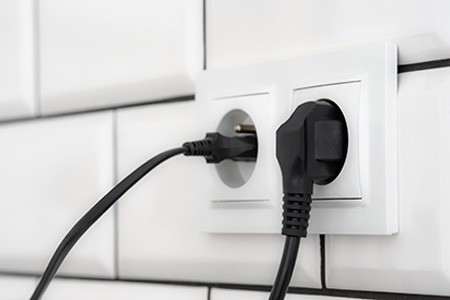
Should a microwave be on its own circuit? Yes, it should have a dedicated circuit. Even a lower wattage countertop microwave, if you want to play it safe, as opposed to a mounted 1000 watt microwave should be isolated in this way. Let’s look at why.
Microwave Operating Requirements
While a microwave typically requires a dedicated circuit, that is not the only specification necessary for the safe operation of the appliance. You'll need to run the device on a 120 or 125-volt circuit using grounded 12/2 NM wiring.
Since microwave power ratings can reach 1,500 watts, meeting the minimum power and circuit requirements for safe operation is essential. However, some microwaves don't have the same appetite for energy. For instance, an 800-watt model might not require the homeowner to comply with the need for a dedicated circuit.
Prevent Outlet Sharing
If no other appliance operates on the same circuit as the microwave, an outlet is essentially a dedicated circuit serving the same purpose of isolating the operation of the microwave. While limiting the number of outlets on a circuit while operating a microwave is safer, it's not always necessary. But regardless, does a microwave need a dedicated circuit? Yes.
Prevent Overheating & Fires
Open the circuit breaker box, and you'll notice a row of breakers. Each operates an independent circuit, whether it's dedicated or shared. If there's a surge in a circuit, the breaker trips to isolate the power surge to that specific circuit and prevent it from spilling over into the rest of the electrical system.
Surges and short circuits occur when an appliance draws too much current from the circuit and overloads the breaker, tripping it. For instance, while modern fridges are more energy efficient than older generation models, they can multiply energy consumption by 4X or more when the compressor activates to cool the refrigerator's interior.
If the fridge shares a circuit with other energy-intensive appliances, it overwhelms the circuit when the compressor activates. As a result, the breaker trips because it can't handle the increased demand for power. The microwave is a similar situation.
However, suppose the home's electrical system has the correct wiring. In that case, the dedicated circuit prevents the overload of the electrical system when operating the fridge and the microwave since they're on dedicated circuits.
The breaker trips if you have a fridge and a microwave operating on the same circuit, and the fridge compressor activates while running the microwave. Without the breaker, your electrical system overloads, and the wiring burns, creating the risk of starting an electrical fire.
What Microwave Wattage Requires a Dedicated Circuit?
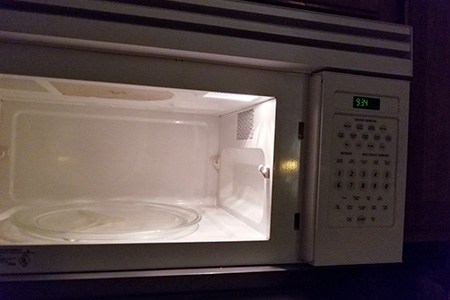
Understanding the power requirements of your microwave is essential to the safe operation of the appliance. Microwaves come in several power ratings, ranging from 600 watts to 1,500 watts or more. Typically, the manufacturer labels the appliance's power rating using a sticker on the door and a plate mounted to the device's rear panel.
However, many homeowners remove the sticker from the door after purchasing the microwave. Also, the manufacturer might not include the information plate on the appliance's rear panel. If that's the case, you'll need to consult the owner's manual you got with the device when purchasing it.
If you bought the appliance second-hand, you might not have the owner's manual to review. If that's the case, search the manufacturer's website for information on your specific microwave model, or email the customer service department about its wattage.
Typically, only microwaves featuring a wattage of 1,000 watts or more require an operation on a dedicated circuit. You can get away with running them on an outlet if the power rating is below this threshold.
NEC Code for Microwaves
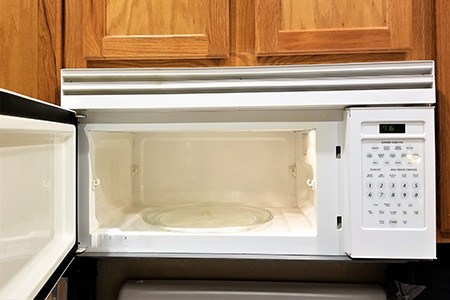
The National Electrical Code (NEC) doesn't address the safe operating guidelines for microwaves. However, NEC regulations feature clauses expected to influence the homeowner's decision to operate any electrical appliance safely.
For instance, the power consumption for any electrical device connected to a circuit shouldn't exceed 80% of the branch circuits rating operating the appliance. So, if you have a 20-amp circuit breaker, appliances connected to that circuit should exceed 16-amps in consumption demand.
If homeowners have appliances fastened in place, the device's power rating shouldn't exceed 50% of the breaker's amp rating. So, if there's a 20-amp breaker governing the circuit, the power requirement shouldn't exceed 10-amps for that circuit. With this in mind, there are two considerations homeowners should be aware of.
Microwaves not built into the electrical system can use up to 80% of the breaker's amp rating. Therefore, if you have a microwave with a 14-amp rating operating on a 15-amp circuit, that would violate NEC regulations.
You'll also need to consider the following two guidelines for the safe operation of the microwave. First, if you have a built-in microwave, the amperage requirements from the appliance shouldn't exceed 50% of the branch circuits rating. For instance, a 15-amp circuit can only handle a microwave with a 7.5-amp rating or less.
Check Local Regulations
The local building code regulation supersedes the guidelines set by the NEC. However, the NEC typically informs the local bodies when formulating their rules and guidelines. That said, the local authorities don't have to comply with NEC guidelines, and they can establish the local code as they see fit. So, homeowners should check the local code requirements before installing a built-in microwave.
What Circuit Does a Microwave Need?
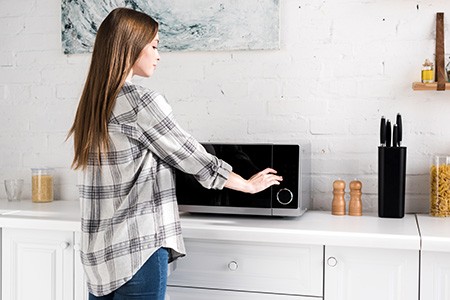
Does a microwave need a dedicated circuit? Yes, but what kind? The power requirements of the microwave typically determine the size of the breaker on the dedicated circuit for the safe operation of the appliance. A 15 or 20-amp breaker is usually sufficient to operate a 1,000-watt microwave without risking circuit and electrical system overload. If you're operating a 1,500-watt microwave, you'll need a 30-amp breaker.
Here's a simple calculation to give homeowners an idea of assessing their microwave's power and circuit requirements.
A 20-amp breaker can support up to 2,400 watts. However, the maximum safety limit for this circuit is 1,920 watts. So, a 20-amp circuit can support a built-in microwave with a power rating of up to 1,000 watts.
Likewise, a 30-amp breaker can support a maximum load of 3,600 watts, with a safety limit of 2,880W. So, a 30-amp breaker can support a microwave with a power rating of up to 2,800 watts.
The standard 1,000-watt microwave requires a 14-amp breaker since they operate intermittently. As a result, it's okay to run them on a 20-amp breaker. That might not be the case for a refrigerator that operates the compressor more often.
This means some homeowners may decide to operate the microwave on a non-dedicated outlet without tripping the breaker or overloading the electrical system. Some microwaves have a demand of 10-amps, making them fine to run on a 15-amp circuit breaker, but the outlet's amp rating should be the same as the breaker managing the circuit.
This setup prevents tripping of the circuit breaker and possible electrical system overload, resulting in the potential of starting an electrical fire.
While American outlets have a 110-volt to 120-volt rating, they usually have a threshold double that (220 to 240 volts) under extenuating circumstances. That said, a 120-volt outlet is sufficient to run a microwave with a power rate under 1,000 watts.
FAQs Regarding Microwaves on Dedicated Circuits
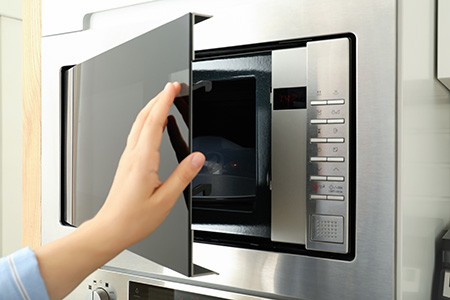
Now that you’re thinking about microwaves having their own circuits, I’m sure all kinds of other common questions have popped in your head. Let’s cover those now.
What Appliances Require a Dedicated Circuit?
Apart from a microwave, several other appliances in the home require the use of a dedicated circuit for safe operations. Some of these devices include the following:
- Electric stove, oven, or range
- Stand-alone chest freezers
- Refrigerator
- Dishwasher
- Garbage disposal
- Countertop convection oven
- Toaster oven
While, with the proper equipment, you can run a microwave on an extensions cord, you should make sure each receives the proper amount of power on a dedicated circuit.
What Happens When a Microwave Short Circuits?
Usually, if a microwave overloads the circuit, it trips the circuit breaker in the breaker box, stopping an electrical fire from occurring.
How Do I Find Out My Microwave Voltage?
Information on the microwave spec plate at the back of the device indicates the appliance's voltage requirements. Typically, a microwave needs 120 volts of alternating current (AC) for effective operation, and it draws 5-amps of current when in use. The 60 Hz rating means that the current alternates 60 times per second.
So, Does a Microwave Need a Dedicated Circuit?
Operating a microwave on a dedicated circuit is recommended, especially if it has a power rating above 1,000 watts. If the power rating for the microwave is under 1,000 watts, it's usually safe to operate it on an outlet. Don't plug the microwave into the same outlet or circuit as a refrigerator or other energy-intensive appliances. So does a microwave need a dedicated circuit? Absolutely.



